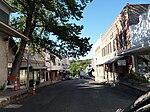Calaveritas, California
Calaveritas ("little skulls" in Spanish; formerly, Upper Calaveritas) is an unincorporated community in Calaveras County, California. It sits on the banks of the Calaveritas Creek at an elevation of 1,109 feet (338 m) above sea level and is located at 38°09′29″N 120°36′36″W. The community is in ZIP code 95249 and area code 209. Founded by Mexicans in 1849, the mining camp was relatively successful and by 1853, Calaveritas was well established, with one livery stable, two butcher shops, several general stores, restaurants, saloons, gambling halls, and fandango houses. Notorious bandit Joaquin Murrieta was supposedly a frequent visitor to the latter two. The town reached its peak in 1857, with an estimated population of around 800, the majority being Mexican or Chinese, but on August 3, 1858, a fire destroyed some of the buildings. By this time, the gold production had declined and some of its inhabitants moved to other locales. The town today is registered as California Historical Landmark #255.Early on, the town was called Upper Calaveritas to distinguish it from another settlement Lower Calaveritas about 3.5 miles to the west. Lower Calaveritas has since become abandoned.
Excerpt from the Wikipedia article Calaveritas, California (License: CC BY-SA 3.0, Authors).Calaveritas, California
Cement Plant Road,
Geographical coordinates (GPS) Address Nearby Places Show on map
Geographical coordinates (GPS)
| Latitude | Longitude |
|---|---|
| N 38.158055555556 ° | E -120.61 ° |
Address
Cement Plant Road
Cement Plant Road
California, United States
Open on Google Maps





